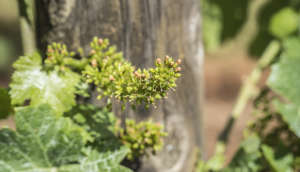The winegrower’s year is marked by milestones: budbreak in spring, harvest in fall and, in between, that pivotal, beautiful time in summer when the vines experience, in rapid succession, bloom, fruit set and shatter. For the first time the vineyard tips its hand and begins to reveal its eventual yield.
When is Bloom?
During bloom, also known as flowering, the petal cover, or cap – called the calyptra – pops off the flower as is bursts out. Bloom is typically about a weeklong process; this year it took place between June 20 and June 27. That’s about two and a half weeks later than last year, but is a return to a more normal schedule. Factors influencing the duration of bloom include weather, topography and vineyard management. Grape type matters, too: Different clones bloom at different times. That translates into a longer bloom period and a longer harvest – good news for us, because it means everything isn’t ready at once.
After bloom, pollination and fertilization immediately ensue. Fertilization is successful in about 30% of the flowers, although it can get as high as 60%. Where fertilization succeeds, fruit set commences: The fertilized flower begins to develop seeds, and a grape berry forms around them.
Where fertilization is unsuccessful, the fruit won’t develop and the unfertilized flowers eventually shatter, or break off and fall to the ground. This year shatter was in the first week of July.

Fruit set is a critically important stage for wine production since it determines the potential crop yield. If the harvest potential was going to be poor, this is the point at which we would find out, by diving into the fields, counting clusters, and making any needed adjustments. That work is under way now, but we’re encouraged that all indications are for another good harvest.
Estimating crop yield is a science unto itself, and it is hands-on work. Our team selects a representative 1% or so of the vines to do a manual count of clusters per vine (also called fruitfulness). Two clusters per shoot is average for both Pinot Noir and Pinot Gris, the dominant grape varieties on the estate.
Even 1% of the estate is a lot of counting, considering that we have 435,533 vines and 400 miles of vine row. Stretch them out and the vines would reach Vancouver, British Columbia, in Canada.
After the Grape Count
After the count, the clusters are weighed during the “lag phase” of berry development – at which point they have achieve about half of their final harvest mass. These numbers are crunched with the planting density and acreage, the findings are projected onto the entire vineyard, and voilà – we have a yield estimate. If the estimate is high, and the vine sets more fruit than we think can ripen, we can adjust by thinning out some clusters. The team’s goal is to estimate within 5% of the final actual yield, and usually they come close.
Like bloom, harvest was early last year. This year we expect things to return to more normal levels, and anticipate harvest beginning at the end of September and lasting into October. In the meantime, while our crews keep busy in the vineyard, the grapes have a few months to hang out and soak up some Oregon sunshine.
